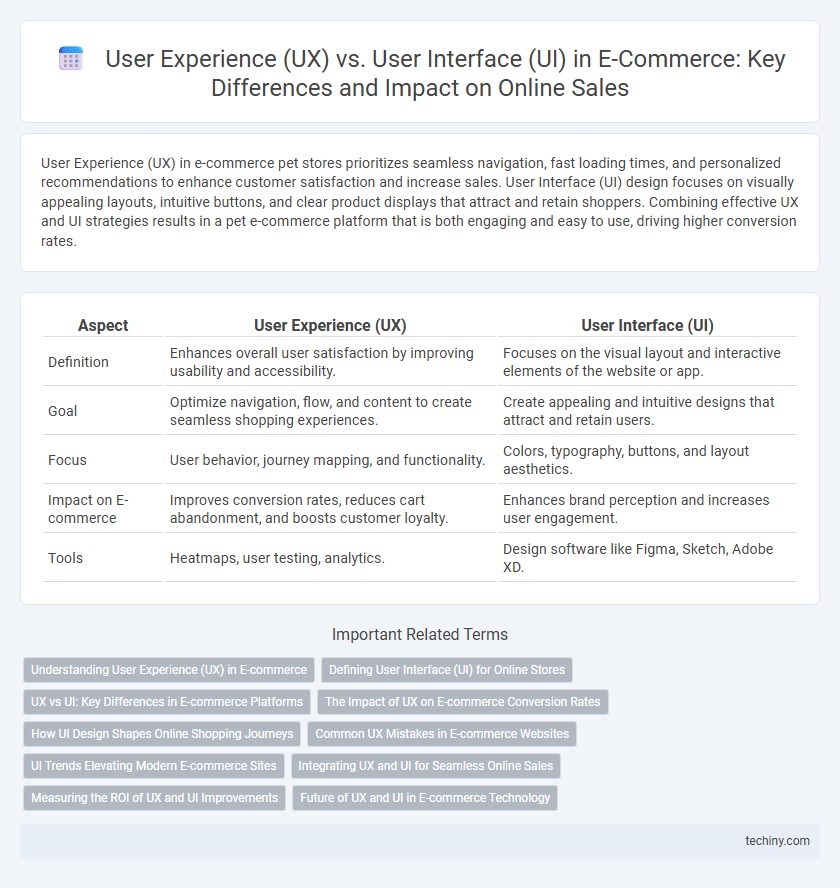User Experience (UX) in e-commerce pet stores prioritizes seamless navigation, fast loading times, and personalized recommendations to enhance customer satisfaction and increase sales. User Interface (UI) design focuses on visually appealing layouts, intuitive buttons, and clear product displays that attract and retain shoppers. Combining effective UX and UI strategies results in a pet e-commerce platform that is both engaging and easy to use, driving higher conversion rates.
Table of Comparison
| Aspect | User Experience (UX) | User Interface (UI) |
|---|---|---|
| Definition | Enhances overall user satisfaction by improving usability and accessibility. | Focuses on the visual layout and interactive elements of the website or app. |
| Goal | Optimize navigation, flow, and content to create seamless shopping experiences. | Create appealing and intuitive designs that attract and retain users. |
| Focus | User behavior, journey mapping, and functionality. | Colors, typography, buttons, and layout aesthetics. |
| Impact on E-commerce | Improves conversion rates, reduces cart abandonment, and boosts customer loyalty. | Enhances brand perception and increases user engagement. |
| Tools | Heatmaps, user testing, analytics. | Design software like Figma, Sketch, Adobe XD. |
Understanding User Experience (UX) in E-commerce
User Experience (UX) in e-commerce involves designing seamless, intuitive shopping journeys that enhance customer satisfaction and increase conversion rates. It encompasses factors such as site navigation, page load speed, personalized recommendations, and secure checkout processes to ensure a frictionless interaction. Optimizing UX leads to higher user retention, reduced cart abandonment, and improved overall brand loyalty.
Defining User Interface (UI) for Online Stores
User Interface (UI) for online stores encompasses the visual elements and interactive components that enable customers to navigate, search, and purchase products seamlessly. Key UI aspects include intuitive navigation menus, clear call-to-action buttons, product image galleries, and responsive design tailored for mobile and desktop devices. A well-crafted UI enhances usability, reduces bounce rates, and directly impacts conversion rates by facilitating a smooth shopping journey.
UX vs UI: Key Differences in E-commerce Platforms
User Experience (UX) in e-commerce focuses on the overall satisfaction and ease of navigation that shoppers encounter when interacting with the platform, including factors like site speed, checkout process, and personalized recommendations. User Interface (UI) refers to the visual elements such as button design, layout, color schemes, and typography that shape how users interact visually with the site. While UI influences first impressions and brand perception, UX drives user engagement and conversion rates by ensuring seamless functionality and intuitive user journeys.
The Impact of UX on E-commerce Conversion Rates
Optimizing User Experience (UX) directly boosts e-commerce conversion rates by simplifying navigation, speeding up site loading times, and enhancing product discovery. Research shows that websites with superior UX design see a 35% increase in sales compared to those focusing primarily on User Interface (UI) aesthetics. Prioritizing seamless checkout processes and personalized content significantly reduces cart abandonment, driving higher customer retention and revenue growth.
How UI Design Shapes Online Shopping Journeys
UI design shapes online shopping journeys by creating visually intuitive layouts that guide users seamlessly through product discovery and checkout processes. Effective UI employs clear visual hierarchy, responsive elements, and consistent branding to reduce friction and enhance user engagement. Optimized UI directly impacts conversion rates by making navigation effortless and fostering trust in the e-commerce platform.
Common UX Mistakes in E-commerce Websites
Common UX mistakes in e-commerce websites include complicated navigation, slow page load times, and unclear call-to-action buttons, which frustrate users and decrease conversion rates. Poor mobile optimization and lack of trust signals such as reviews or secure payment badges also negatively impact user confidence and purchase decisions. Simplifying checkout processes and providing intuitive search functions significantly enhance the overall shopping experience and drive sales growth.
UI Trends Elevating Modern E-commerce Sites
Cutting-edge UI trends such as immersive 3D visuals, microinteractions, and dark mode integration are transforming modern e-commerce sites by enhancing user engagement and visual appeal. Adaptive layouts optimized for mobile and voice-activated interfaces are driving seamless navigation and accessibility, which directly boost conversion rates. Incorporating dynamic content personalization powered by AI algorithms further refines the shopping experience, aligning UI design with evolving consumer expectations.
Integrating UX and UI for Seamless Online Sales
Integrating UX and UI optimizes the e-commerce journey by aligning intuitive design with user-centric functionality, reducing friction during the purchasing process. Effective UX research combined with visually appealing UI elements enhances customer satisfaction, increases conversion rates, and drives repeat sales. Prioritizing seamless navigation, fast load times, and responsive design creates an immersive shopping experience that supports online sales growth and brand loyalty.
Measuring the ROI of UX and UI Improvements
Measuring the ROI of UX and UI improvements in e-commerce involves analyzing metrics such as conversion rates, average order value, and customer retention. Enhanced UX typically drives higher customer satisfaction and reduces bounce rates, while UI optimizations improve navigation efficiency and visual appeal, directly impacting user engagement. Combining data from A/B testing, heatmaps, and user feedback provides quantifiable insights that link design enhancements to revenue growth.
Future of UX and UI in E-commerce Technology
Emerging trends in E-commerce technology emphasize the convergence of User Experience (UX) and User Interface (UI) to create more intuitive, personalized shopping environments driven by AI and machine learning algorithms. Voice commerce, augmented reality (AR), and immersive interfaces are transforming traditional UI elements into seamless UX journeys that anticipate consumer needs and behaviors. Advanced UX/UI design frameworks leveraging big data analytics enable E-commerce platforms to optimize conversion rates, increase customer loyalty, and deliver adaptive, responsive interfaces across multiple devices.
User Experience (UX) vs User Interface (UI) Infographic

 techiny.com
techiny.com